Gooooooooooo Navyyyyyyyy~~~
Mar 14, 2016 21:55:25 #
GO NAVY!!
Subject: The U.S. Navys new $13 billion aircraft carrier will dominate the seas!
The U.S. Navys new $13 billion aircraft carrier will dominate the seas!
The shipbuilders are on track to deliver Gerald R. Ford to the U.S. Navy in 2016.
Its scheduled to be launched this month, and can support laser guns and dynamic armor.
A $13 billion U.S. aircraft carrier is about to hit the open seas.
DCS13-641-46 Newport News Shipbuilding file
Its the USS Gerald R. Ford (CVN-78), the most expensive and most advanced warship ever built. The ship was christened in November 2013 and is scheduled to be commissioned this month.
The Naval behemoth can house more than 4,500 people and weighs 90,000 tons. The CVN-78 is the lead ship in the Ford class of aircraft carriers, replacing some of the U.S. Navys existing Nimitz-class carriers. At first glance, both classes have a similar-looking hull, but the Ford class introduces a series of technical innovations designed to improve carriers operating efficiency, and reduce operating costs and crew requirements.
Instead of conventional steam catapults to launch jets, the supercarrier is outfitted with EMALS (Electromagnetic Aircraft Launch System), which is lighter and requires less space. It also needs less maintenance and manpower, and is more reliable and energy-efficient. EMALS can launch an aircraft every 45 seconds, 25% faster than its steam counterpart. Furthermore, since EMALS uses no steam, its a suitable candidate for launching drones and other electric vehicles.
The launch system is just a small piece of the CVN-78s puzzle. The ship has a redesigned and relocated island (the part of the carrier where air-traffic control and the bridge are located), three faster and more powerful elevators (compared with four on Nimitz-class carriers), an Advanced Aircraft Recovery System (AARS) and design changes to the flight deck. Those changes are vital to increasing the number of sorties launched.
The carriers sensory array has received an overhaul with the addition of an integrated active electronically scanned array (AESA) search-and-tracking radar system. This new system has no moving parts, so it therefore minimizes maintenance and crew requirements for operation. Further, advanced AESA radars enable the ship and aircraft to broadcast powerful signals while remaining stealthy, which greatly improves combat effectiveness.
Speaking of combat, the carrier is more than capable of holding its own. The Evolved SeaSparrow Missile (ESSM) defends against high-speed, highly maneuverable anti-ship missiles, and the weapon system of choice is the Rolling Airframe Missile (RAM). One must not forget various Gatling and heavy machine gun mounts as well as 75-plus aircraft ready to be launched at any given time.
The CVN-78 has another important advantage over its equivalent Nimitz class carrier: Its power doesnt come with the price of increased hands on board. In fact, because of the aforementioned technologies, the USS Gerald R. Ford accommodates 2,600 sailors, 600 fewer than a Nimitz-class flat top. This alone saves the Navy more than $4 billion in ownership costs over each ships 50-year life, when compared with contemporary Nimitz aircraft carriers.
As expected, the CVN-78 has impressive power. The ship is powered by two Bechtel A1B nuclear reactors, each capable of producing 300 megawatts of electricity, triple that of Nimitz-class reactors. Those changes resulted in a two-thirds reduction of watchstanding requirements and a big decrease in required maintenance.
With great power comes great firepower. Only half of the power-generating capability on the CVN-78 is needed to run currently planned systems, including EMALS. The CVN-78 will thus have the power reserves that the Nimitz class lacks to sport even more futuristic armaments and systems, such as free-electron lasers and dynamic armor, at some point in the future.
The lasers can be fired at just a few dollars per shot and consume around 10 megawatts of power.
As you can see, the USS Gerald R. Ford packs a serious punch its a massive investment in strategic dominance and innovation that, in spite of rising concerns, should provide the U.S. with the upper hand in 21st-century naval warfare.
Subject: The U.S. Navys new $13 billion aircraft carrier will dominate the seas!
The U.S. Navys new $13 billion aircraft carrier will dominate the seas!
The shipbuilders are on track to deliver Gerald R. Ford to the U.S. Navy in 2016.
Its scheduled to be launched this month, and can support laser guns and dynamic armor.
A $13 billion U.S. aircraft carrier is about to hit the open seas.
DCS13-641-46 Newport News Shipbuilding file
Its the USS Gerald R. Ford (CVN-78), the most expensive and most advanced warship ever built. The ship was christened in November 2013 and is scheduled to be commissioned this month.
The Naval behemoth can house more than 4,500 people and weighs 90,000 tons. The CVN-78 is the lead ship in the Ford class of aircraft carriers, replacing some of the U.S. Navys existing Nimitz-class carriers. At first glance, both classes have a similar-looking hull, but the Ford class introduces a series of technical innovations designed to improve carriers operating efficiency, and reduce operating costs and crew requirements.
Instead of conventional steam catapults to launch jets, the supercarrier is outfitted with EMALS (Electromagnetic Aircraft Launch System), which is lighter and requires less space. It also needs less maintenance and manpower, and is more reliable and energy-efficient. EMALS can launch an aircraft every 45 seconds, 25% faster than its steam counterpart. Furthermore, since EMALS uses no steam, its a suitable candidate for launching drones and other electric vehicles.
The launch system is just a small piece of the CVN-78s puzzle. The ship has a redesigned and relocated island (the part of the carrier where air-traffic control and the bridge are located), three faster and more powerful elevators (compared with four on Nimitz-class carriers), an Advanced Aircraft Recovery System (AARS) and design changes to the flight deck. Those changes are vital to increasing the number of sorties launched.
The carriers sensory array has received an overhaul with the addition of an integrated active electronically scanned array (AESA) search-and-tracking radar system. This new system has no moving parts, so it therefore minimizes maintenance and crew requirements for operation. Further, advanced AESA radars enable the ship and aircraft to broadcast powerful signals while remaining stealthy, which greatly improves combat effectiveness.
Speaking of combat, the carrier is more than capable of holding its own. The Evolved SeaSparrow Missile (ESSM) defends against high-speed, highly maneuverable anti-ship missiles, and the weapon system of choice is the Rolling Airframe Missile (RAM). One must not forget various Gatling and heavy machine gun mounts as well as 75-plus aircraft ready to be launched at any given time.
The CVN-78 has another important advantage over its equivalent Nimitz class carrier: Its power doesnt come with the price of increased hands on board. In fact, because of the aforementioned technologies, the USS Gerald R. Ford accommodates 2,600 sailors, 600 fewer than a Nimitz-class flat top. This alone saves the Navy more than $4 billion in ownership costs over each ships 50-year life, when compared with contemporary Nimitz aircraft carriers.
As expected, the CVN-78 has impressive power. The ship is powered by two Bechtel A1B nuclear reactors, each capable of producing 300 megawatts of electricity, triple that of Nimitz-class reactors. Those changes resulted in a two-thirds reduction of watchstanding requirements and a big decrease in required maintenance.
With great power comes great firepower. Only half of the power-generating capability on the CVN-78 is needed to run currently planned systems, including EMALS. The CVN-78 will thus have the power reserves that the Nimitz class lacks to sport even more futuristic armaments and systems, such as free-electron lasers and dynamic armor, at some point in the future.
The lasers can be fired at just a few dollars per shot and consume around 10 megawatts of power.
As you can see, the USS Gerald R. Ford packs a serious punch its a massive investment in strategic dominance and innovation that, in spite of rising concerns, should provide the U.S. with the upper hand in 21st-century naval warfare.
To be launched this month
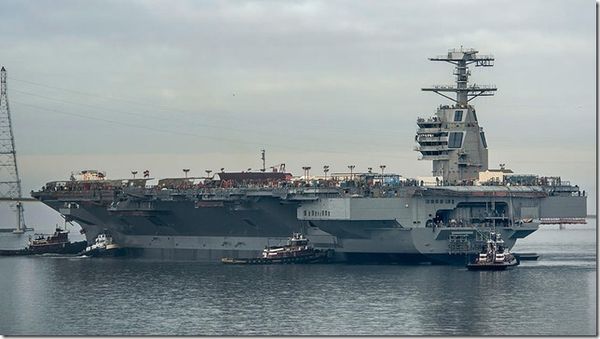
Its the USS Gerald R. Ford (CVN-78), the most expensive and most advanced warship ever built.
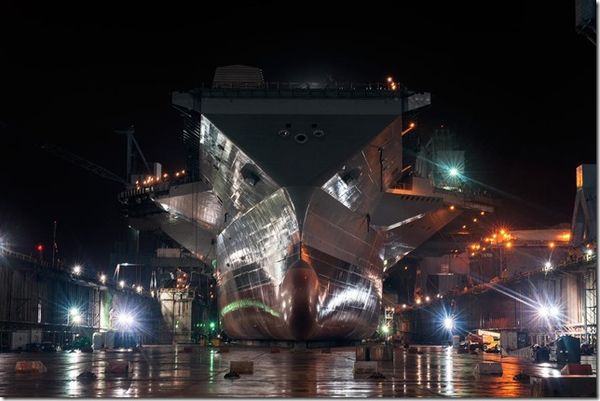
combat, the carrier is more than capable of holding its own. The Evolved SeaSparrow Missile (ESSM) defends against high-speed, highly maneuverable anti-ship missiles, and the weapon system of choice is the Rolling Airframe Missile (RAM). One must not forget vari
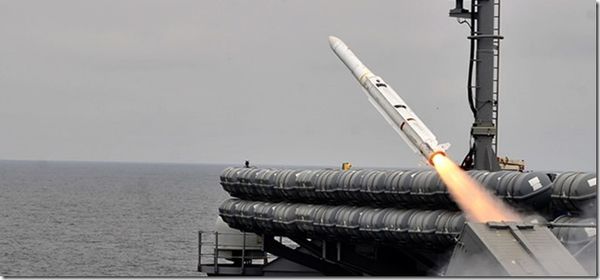
power comes great firepower
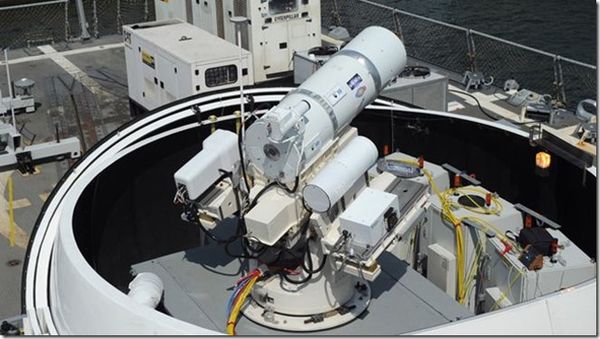
its a massive investment in strategic dominance and innovation that, in spite of rising concerns, should provide the U.S. with the upper hand in 21st-century naval warfare.
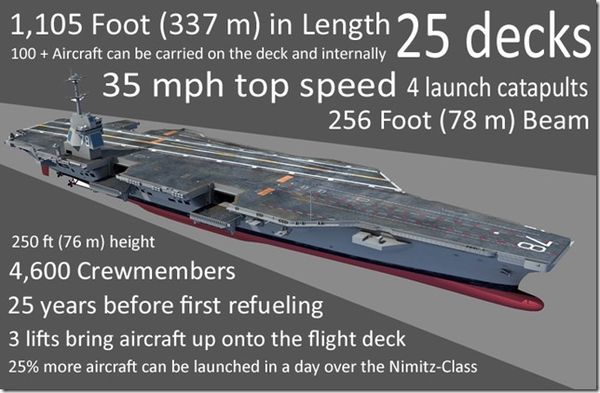
Mar 14, 2016 22:40:20 #
Old Navy vet here. Thats a big ship wonder if a gps would work on board. Think i would have trouble finding my way around.
lindajoy wrote:
GO NAVY!! br br Subject: The U.S. Navys new $13 ... (show quote)
Mar 14, 2016 22:46:38 #
lindajoy wrote:
GO NAVY!! br br Subject: The U.S. Navys new $13 ... (show quote)
Very interesting. I work with a Vietnam era sailor. Note: looking forward to the return of your regular picture.😉
Mar 14, 2016 23:12:02 #
Squiddiddler wrote:
Old Navy vet here. Thats a big ship wonder if a gps would work on board. Think i would have trouble finding my way around.
She's twice as wide as the crewboats I ran were long....lol.....yep pretty big!!!!
Mar 14, 2016 23:30:02 #
Squiddiddler wrote:
Old Navy vet here. Thats a big ship wonder if a gps would work on board. Think i would have trouble finding my way around.
I think you could hide very well on it and not worry about seeing anyone for sometime if you didn't want to........
I read about it today and was just so impressed..I mean 90 tons and still hits 35 mph top speed??? 25 decks and go 25 years before refueling??? Reallyyyyyyyyyy?? Amazing..If it can do that, can you just imagine what she can do in War time needs???
Why can't out cars go 25 yrs before refueling???
Thank You for your service Squiddiddler...When were you in??? :
Mar 14, 2016 23:32:17 #
John316 wrote:
Very interesting. I work with a Vietnam era sailor. Note: looking forward to the return of your regular picture.😉
Glad you liked it~~IT still has me going, reallyyyy, what a ship!~~~
I hope we never have to use what it is capable of doing, but if we do then I am glad we have it and not another country!!!
God Bless the USA !!!
Mar 15, 2016 00:14:56 #
Mar 15, 2016 01:20:28 #
A little more history about the new super carrier~~
PCU Gerald R. Ford (CVN-78) is to be the lead ship of her class of United States Navy supercarriers. As announced by the U.S. Navy on 16 January 2007, the ship is named after the 38th President of the United States Gerald R. Ford, whose World War II naval service included combat duty aboard the light aircraft carrier Monterey in the Pacific Theater.[9]
The keel of Gerald R. Ford was laid down on 13 November 2009.[3] Construction began on 11 August 2005, when Northrop Grumman held a ceremonial steel cut for a 15-ton plate that forms part of a side shell unit of the carrier.[10] She was christened on 9 November 2013.[2] The schedule calls for the ship to join the U.S. Navy's fleet in March 2016 with the first deployment in 2019.[6] Gerald R. Ford will enter the fleet replacing the inactive USS Enterprise (CVN-65), which ended her 51 years of active service in December 2012.[11][12]
On 3 January 2007, former United States Secretary of Defense Donald Rumsfeld announced that the aircraft carrier would be named after Ford during a eulogy for President Ford at Grace Episcopal Church in East Grand Rapids, Michigan.[17] Rumsfeld indicated that he had personally told Ford of the honor during a visit to his home in Rancho Mirage a few weeks before Ford's death. This makes the aircraft carrier one of the few U.S. ships named after a living person. Later in the day, the Navy confirmed that the aircraft carrier would indeed be named after the former President.[18] On 16 January 2007, Navy Secretary Donald Winter officially named CVN-78 USS Gerald R. Ford. Ford's daughter Susan Ford Bales was named the ship's sponsor. The announcements were made at a Pentagon ceremony attended by Vice President Dick Cheney, Senators Warner (R-VA) and Levin (D-MI), Major General Guy C. Swan III, Bales, Ford's other three children, and others.[19]
The USS America Carrier Veterans Association (CVA) had pushed to name the ship USS America. The CVA is an association of sailors who served aboard USS America (CV-66), which was decommissioned in 1996 and scuttled in the Atlantic as part of a damage test of large deck aircraft carriers in 2005.[20] Eventually, LHA-6 was named America.
The ship is equipped with two newly-designed reactors and has 250 percent more electrical capacity than previous carriers. The improvements will allow the ship to load weapons and launch aircraft faster than ever before.
PCU Gerald R. Ford (CVN-78) is to be the lead ship of her class of United States Navy supercarriers. As announced by the U.S. Navy on 16 January 2007, the ship is named after the 38th President of the United States Gerald R. Ford, whose World War II naval service included combat duty aboard the light aircraft carrier Monterey in the Pacific Theater.[9]
The keel of Gerald R. Ford was laid down on 13 November 2009.[3] Construction began on 11 August 2005, when Northrop Grumman held a ceremonial steel cut for a 15-ton plate that forms part of a side shell unit of the carrier.[10] She was christened on 9 November 2013.[2] The schedule calls for the ship to join the U.S. Navy's fleet in March 2016 with the first deployment in 2019.[6] Gerald R. Ford will enter the fleet replacing the inactive USS Enterprise (CVN-65), which ended her 51 years of active service in December 2012.[11][12]
On 3 January 2007, former United States Secretary of Defense Donald Rumsfeld announced that the aircraft carrier would be named after Ford during a eulogy for President Ford at Grace Episcopal Church in East Grand Rapids, Michigan.[17] Rumsfeld indicated that he had personally told Ford of the honor during a visit to his home in Rancho Mirage a few weeks before Ford's death. This makes the aircraft carrier one of the few U.S. ships named after a living person. Later in the day, the Navy confirmed that the aircraft carrier would indeed be named after the former President.[18] On 16 January 2007, Navy Secretary Donald Winter officially named CVN-78 USS Gerald R. Ford. Ford's daughter Susan Ford Bales was named the ship's sponsor. The announcements were made at a Pentagon ceremony attended by Vice President Dick Cheney, Senators Warner (R-VA) and Levin (D-MI), Major General Guy C. Swan III, Bales, Ford's other three children, and others.[19]
The USS America Carrier Veterans Association (CVA) had pushed to name the ship USS America. The CVA is an association of sailors who served aboard USS America (CV-66), which was decommissioned in 1996 and scuttled in the Atlantic as part of a damage test of large deck aircraft carriers in 2005.[20] Eventually, LHA-6 was named America.
The ship is equipped with two newly-designed reactors and has 250 percent more electrical capacity than previous carriers. The improvements will allow the ship to load weapons and launch aircraft faster than ever before.
Mar 15, 2016 01:21:22 #
Squiddiddler wrote:
1954-62
Thank You again for your service, Squiddiddler.......You are why we remain free~~~ :thumbup: :thumbup:
Mar 15, 2016 01:34:20 #
lpnmajor
Loc: Arkansas
lindajoy wrote:
GO NAVY!! br br Subject: The U.S. Navys new $13 ... (show quote)
That's why the Air Force is jealous, they can't carry their airfields around with them. :lol:
Mar 15, 2016 05:41:44 #
lindajoy wrote:
GO NAVY!! br br Subject: The U.S. Navys new $13 ... (show quote)
Very impressive! I served aboard 2 carriers, the USS Kitty Hawk, and the USS Ticonderoga, as an aviation ordnanceman, loading bombs aboard aircraft during the Vietnam war.
Mar 15, 2016 07:39:32 #
lpnmajor wrote:
That's why the Air Force is jealous, they can't carry their airfields around with them. :lol:
Good one~!!! Don't they just make there's as needed?? They just take over the country, build a field and wella~~ :shock:
Mar 15, 2016 07:43:57 #
waltmoreno wrote:
Very impressive! I served aboard 2 carriers, the USS Kitty Hawk, and the USS Ticonderoga, as an aviation ordnanceman, loading bombs aboard aircraft during the Vietnam war.
Thank You for your service walt....May I ask, what time period??
Of the two you served on did you have a preference?? If so, why? Performance wise which was better, if any??
Mar 15, 2016 08:22:17 #
lindajoy wrote:
Thank You for your service walt....May I ask, what time period??
Of the two you served on did you have a preference?? If so, why? Performance wise which was better, if any??
Of the two you served on did you have a preference?? If so, why? Performance wise which was better, if any??
Sure. I made a westpac cruise aboard each carrier; the Ticonderoga in '64, (smack in the middle of the Gulf of Tonkin incident), and the Kitty Hawk in '65-'66.
Th Kitty Hawk was almost brand new when I served aboard it and so it was vastly preferable to the aging Ticonderoga.
Mar 15, 2016 08:34:07 #
lindajoy wrote:
GO NAVY!! br br Subject: The U.S. Navys new $13 ... (show quote)
Bad ass indeed. :thumbup:
With all of the cutbacks to our military that dimwit in the WH has done, I'm surprised about this.
If you want to reply, then register here. Registration is free and your account is created instantly, so you can post right away.




